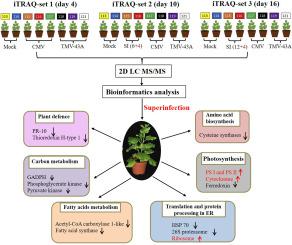Journal of Proteomics ( IF 3.3 ) Pub Date : 2020-08-25 , DOI: 10.1016/j.jprot.2020.103948 Xin Yang 1 , Prem Prakash Das 2 , Peter Oppenheimer 3 , Guohui Zhou 4 , Sek-Man Wong 5

|
Heterologous superinfection exclusion (HSE) is a phenomenon of an initial virus infection which prevents reinfection by a distantly related or unrelated challenger virus strain in the same host. Here, we demonstrate that a mild strain mutant of Tobacco mosaic virus (TMV-43A) can protect Nicotiana benthamiana plants against infection by a challenger Cucumber mosaic virus (CMV)-Fny strain. The isobaric tags for relative and absolute quantification (iTRAQ) technique was used to investigate proteome of N. benthamiana plant during HSE. Our results indicated that in superinfected plants, the PSI and PSII proteins in the photosynthetic pathway increased in abundance, providing sufficient energy to plants for survival. The fatty acid synthesis-related proteins acetyl-CoA carboxylase 1-like and fatty acid synthase were decreased in abundance, affecting the formation of virus replication complex, which in turn reduced CMV replication and lessen hijacking of basic building blocks of RNA transcription and protein synthesis required for normal host functions. This is the first analyses of host proteins that are correlated to HSE between two unrelated plant viruses TMV-43A and CMV in N. benthamiana plants.
Biological significance
CMV is one of the most studied host-virus interaction models in plants. It infects both monocot and dicot crop plants, causing significant economic losses. Superinfection exclusion (also known as cross protection) is one of the methods to combat virus infection. However, there is lack of proteome information of heterologous superinfection exclusion between two taxonomically unrelated plant viruses (such as between CMV and TMV). An iTRAQ-based quantitative approach was used to study proteomics of superinfection, where TMV-43A acts as a protector of N. benthamiana plants against its challenger CMV. Results showed that TMV-43A protects host plants and prevents plant death from CMV infection. This study provided insights into host responses involving multiple host pathways: photosynthesis, plant defence, carbon metabolism, translation and protein processing, fatty acid metabolism and amino acid biosynthesis. The findings provide a reference database for other viruses and increase our knowledge in host proteins that are correlated to superinfection.
中文翻译:

基于iTRAQ的蛋白质分析提供了针对烟草(Nicotiana benthamiana)植物中针对CMV的TMV-43A异源重叠感染排除的见解。
异源超级感染排除(HSE)是初始病毒感染的一种现象,可防止同一宿主中的远缘或无关的挑战者病毒株再次感染。在这里,我们证明了烟草花叶病毒(TMV-43A)的轻毒株突变体可以保护本生烟草植物免受挑战者黄瓜花叶病毒(CMV)-Fny株的感染。相对定量和绝对定量(iTRAQ)技术的等压标记用于研究本氏烟草的蛋白质组。HSE期间的工厂。我们的结果表明,在超级感染的植物中,光合作用途径中的PSI和PSII蛋白大量增加,从而为植物提供了足够的能量来存活。脂肪酸合成相关蛋白乙酰辅酶A羧化酶1-样和脂肪酸合酶大量减少,影响了病毒复制复合物的形成,从而减少了CMV复制并减少了RNA转录和蛋白质合成的基本结构劫持。正常主机功能所需。这是对本生烟草中两种不相关植物病毒TMV-43A和CMV之间与HSE相关的宿主蛋白的首次分析。
生物学意义
CMV是植物中研究最多的宿主-病毒相互作用模型之一。它同时感染单子叶植物和双子叶植物,造成巨大的经济损失。排除超级感染(也称为交叉保护)是抵抗病毒感染的方法之一。但是,缺少两种分类学上不相关的植物病毒(例如CMV和TMV之间)的异源重复感染排斥的蛋白质组信息。基于iTRAQ的定量方法用于研究超级感染的蛋白质组学,其中TMV-43A充当本氏烟草的保护者对抗其挑战者CMV的植物。结果表明,TMV-43A保护寄主植物并防止植物因CMV感染而死亡。这项研究提供了对涉及多种宿主途径的宿主反应的见解:光合作用,植物防御,碳代谢,翻译和蛋白质加工,脂肪酸代谢和氨基酸生物合成。这些发现为其他病毒提供了参考数据库,并增加了我们对与超级感染相关的宿主蛋白的了解。



























 京公网安备 11010802027423号
京公网安备 11010802027423号